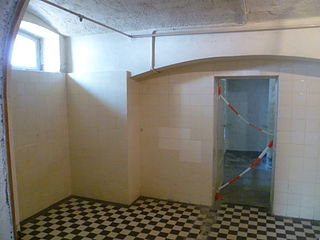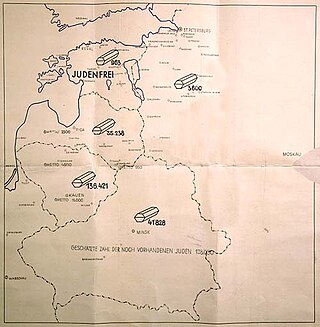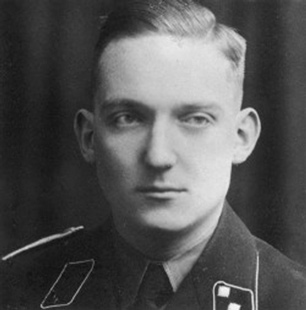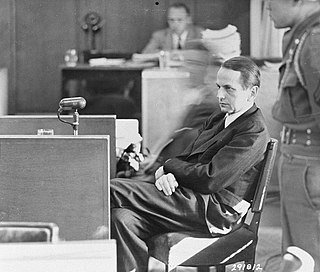Related Research Articles

The Nuremberg trials were held by the Allies against representatives of the defeated Nazi Germany for plotting and carrying out invasions of other countries and atrocities against their citizens in World War II.

The Doctors' Trial was the first of 12 trials for war crimes of high-ranking German officials and industrialists that the United States authorities held in their occupation zone in Nuremberg, Germany, after the end of World War II. These trials were held before US military courts, not before the International Military Tribunal, but took place in the same rooms at the Palace of Justice. The trials are collectively known as the "subsequent Nuremberg trials", formally the "Trials of War Criminals before the Nuremberg Military Tribunals" (NMT).

Einsatzgruppen were Schutzstaffel (SS) paramilitary death squads of Nazi Germany that were responsible for mass murder, primarily by shooting, during World War II (1939–1945) in German-occupied Europe. The Einsatzgruppen had an integral role in the implementation of the so-called "Final Solution to the Jewish question" in territories conquered by Nazi Germany, and were involved in the murder of much of the intelligentsia and cultural elite of Poland, including members of the Catholic priesthood. Almost all of the people they murdered were civilians, beginning with the intelligentsia and swiftly progressing to Soviet political commissars, Jews, and Romani people, as well as actual or alleged partisans throughout Eastern Europe.

The Frankfurt Auschwitz trials, known in German as Der Auschwitz-Prozess, or Der zweite Auschwitz-Prozess, was a series of trials running from 20 December 1963 to 19 August 1965, charging 22 defendants under German criminal law for their roles in the Holocaust as mid- to lower-level officials in the Auschwitz-Birkenau death and concentration camp complex. Hans Hofmeyer led as Chief Judge the "criminal case against Mulka and others".

Emil Haussmann was a German SS functionary during the Nazi era. He was part of Einsatzkommando 12 of Einsatzgruppe D, which perpetrated the Holocaust in occupied Ukraine. Haussmann was charged with crimes against humanity in 1947 in the Einsatzgruppen Trial. Two days after his indictment, Haussmann committed suicide.

The Hadamar killing centre was a killing facility involved in the Nazi involuntary euthanasia programme known as Aktion T4. It was housed within a psychiatric hospital located in the German town of Hadamar, near Limburg in Hessen.

The Jäger Report, also Jaeger Report was written on 1 December 1941 by Karl Jäger, commander of Einsatzkommando 3, a death squad of Einsatzgruppe A attached to Army Group North in the Operation Barbarossa. It is the most detailed and precise surviving chronicle of the activities of one individual Einsatzkommando, and a key record documenting the Holocaust in Lithuania as well as in Latvia and Belarus.

Nazi crime or Hitlerite crime is a legal concept used in the Polish legal system, referring to an action which was carried out, inspired, or tolerated by public functionaries of Nazi Germany (1933–1945) that is also classified as a crime against humanity or other persecutions of people due to their membership in a particular national, political, social, ethnic or religious group.
A number of war crimes trials were held during the Soviet occupation of Estonia (1944–1991). The best-known trial was brought in 1961, by the Soviet authorities against local collaborators who had participated in the Holocaust during the German occupation (1941–1944). The accused were charged with murdering up to 5,000 German and Czechoslovakian Jews and Romani people near the Kalevi-Liiva concentration camp in 1942–1943. The public trial by the Supreme Court of the Estonian SSR was held in the auditorium of the Navy Officers Club in Tallinn and attended by a mass audience. All three defendants were convicted and sentenced to death, one in absentia. The two defendants present for the trial were executed shortly after. The third defendant, Ain-Ervin Mere, was not available for execution.

Martin Sandberger was a German SS functionary during the Nazi era and a convicted Holocaust perpetrator. He commanded Sonderkommando 1a of Einsatzgruppe A, as well as the Sicherheitspolizei and SD at the time of Nazi German occupation of Estonia during World War II. Sandberger perpetrated mass murder of the Jews in German-occupied Latvia and Estonia. He was also responsible for the arrest of Jews in Italy, and their deportation to Auschwitz concentration camp. Sandberger was the second-highest official of the Einsatzgruppe A to be tried and convicted. He was also the last-surviving defendant from the Nuremberg Military Tribunals.

The Central Office of the State Justice Administrations for the Investigation of National Socialist Crimes is Germany's main agency responsible for investigating war crimes during Nazi rule. The commission possesses the largest collection of files, documentation and materials concerning criminal activities during Nazi rule. The Central Office is located in Ludwigsburg.

The Holocaust in Russia is the Nazi crimes during the occupation of Russia by Nazi Germany.

In 1960, the major Holocaust perpetrator Adolf Eichmann was captured in Argentina by Israeli agents and brought to Israel to stand trial. The capturing of Eichmann was criticized by the United Nations, calling it a "violation of the sovereignty of a Member State". His trial, which opened on 11 April 1961, was televised and broadcast internationally, intended to educate about the crimes committed against Jews, which had been secondary to the Nuremberg trials. Prosecutor and Attorney General Gideon Hausner also tried to challenge the portrayal of Jewish functionaries that had emerged in the earlier trials, showing them at worst as victims forced to carry out Nazi decrees while minimizing the "gray zone" of morally questionable behavior. Hausner later wrote that available archival documents "would have sufficed to get Eichmann sentenced ten times over"; nevertheless, he summoned more than 100 witnesses, most of whom had never met the defendant, for didactic purposes. Defense attorney Robert Servatius refused the offers of twelve survivors who agreed to testify for the defense, exposing what they considered immoral behavior by other Jews. Political philosopher Hannah Arendt reported on the trial in her book Eichmann in Jerusalem: A Report on the Banality of Evil. The book had enormous impact in popular culture, but its ideas have become increasingly controversial.

Hermann Schaper, was a German SS functionary during the Nazi era. He was a Holocaust perpetrator responsible for atrocities committed by the Einsatzgruppen in German-occupied Poland and the Soviet Union and was convicted after the war of numerous war crimes.

The two Treblinka trials concerning the Treblinka extermination camp personnel began in 1964. Held at Düsseldorf in West Germany, they were the two judicial trials in a series of similar war crime trials held during the early 1960s, such as the Jerusalem Adolf Eichmann trial (1961) and the Frankfurt Auschwitz Trials (1963–65), as a result of which the general public came to realize the extent of the crimes that some two decades earlier had been perpetrated in occupied Poland by German bureaucrats and their willing executioners. In the subsequent years, separate trials dealt with personnel of the Bełżec (1963–65), Sobibor (1966), and Majdanek (1975–81) extermination camps.
The Kharkov Trial was a war crimes trial held in front of a Soviet military tribunal in December 1943 in Kharkov, Soviet Union. Defendants included one Soviet collaborator, as well as German military, police, and SS personnel responsible for implementing the occupational policies during the German–Soviet War of 1941–45. The trial was the first time that German personnel had been tried for war crimes by the Allies during and after World War II.

The Ivanhorod Einsatzgruppen photograph is a prominent depiction of the Holocaust in Ukraine, on the Eastern Front of World War II. Dated to 1942, it shows a soldier aiming his rifle at a woman who is trying to shield a child with her body, portraying one of numerous genocidal killings carried out against Jews by the Einsatzgruppen within German-occupied Europe. It was taken in Ivanhorod, a village in German-occupied Ukraine, before being mailed to Nazi Germany. However, the Polish resistance intercepted the photograph in Warsaw, and it was subsequently kept as Holocaust imagery by Polish photographer Jerzy Tomaszewski. In the 1960s, it was alleged that the photograph was a communist forgery, but that claim was eventually proven false. Since then, it has been frequently used in books, museums, and exhibitions focused on the Holocaust. British photographic historian Janina Struk describes it as "a symbol of the barbarity of the Nazi regime and their industrial-scale murder of six million European Jews."
Einsatzgruppe H was one of the Einsatzgruppen, the paramilitary death squads of Nazi Germany. A special task force of more than 700 soldiers, it was created at the end of August 1944 to deport or murder the remaining Jews in Slovakia following the German suppression of the Slovak National Uprising. During its seven-month existence, Einsatzgruppe H collaborated closely with the Hlinka Guard Emergency Divisions and arrested 18,937 people, of whom at least 2,257 were murdered; thousands of others were deported to Nazi concentration camps. The victims included Jews, Romani people, actual or suspected Slovak partisans, and real or perceived political opponents. One of its component units, Einsatzkommando 14, committed the two of the largest massacres in the history of Slovakia, at Kremnička and Nemecká.
The Nazis and Nazi Collaborators (Punishment) Law is a 1950 Israeli law passed by the First Knesset that provides a legal framework for the prosecution of crimes against Jews and other persecuted people committed in Nazi Germany, German-occupied Europe, or territory under the control of another Axis power between 1933 and 1945. The law's primary target was Jewish Holocaust survivors alleged to have collaborated with the Nazis, in particular prisoner functionaries ("kapos") and the Jewish Ghetto Police. It was motivated by the anger of survivors against perceived collaborators and a desire to "purify" the community.

Genocide justification is the claim that a genocide is morally excusable/defensible, necessary, and/or sanctioned by law. Genocide justification differs from genocide denial, which is the attempt to reject the occurrence of genocide. Perpetrators often claim that genocide victims presented a serious threat, justifying their actions by stating it was legitimate self-defense of a nation or state. According to modern international criminal law, there can be no excuse for genocide. Genocide is often camouflaged as military activity against combatants, and the distinction between denial and justification is often blurred.
References
- ↑ Patrick Tobin, Crossroads at Ulm: Postwar West Germany and the 1958 Ulm Einsatzkommando Trial, PhD dissertation, University of North Carolina at Chapel Hill, 2013. Abstract. Accessed 30 September 2016.
- ↑ Sonia Phalnikar, Landmark Trial Pushed Germany to Tackle Nazi Past (an interview with Dieter Pohl (historian) ), Deutsche Welle, 20 May 2008. Accessed 30 September 2016.
- 1 2 3 Andreas Mix: Als Westdeutschland aufwachte. einestages, 27. April 2008.
- ↑ "Crossroads at Ulm: Postwar West Germany and the 1958 Ulm Einsatzkommando Trial". cdr.lib.unc.edu. Retrieved 2024-01-16.
- ↑ Bazyler, Michael (2016). Holocaust, Genocide, and the Law: A Quest for Justice in a Post-Holocaust World. New York: Oxford University Press. p. 120. ISBN 978-0-19-539569-3.
- ↑ Bazyler, Michael (2016). Holocaust, Genocide, and the Law: A Quest for Justice in a Post-Holocaust World. New York: Oxford University Press. p. 111. ISBN 978-0-19-539569-3.